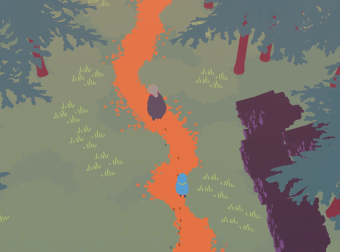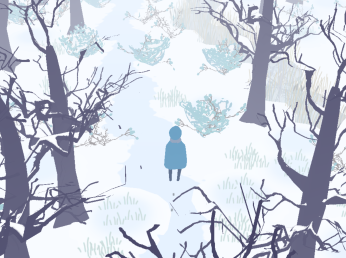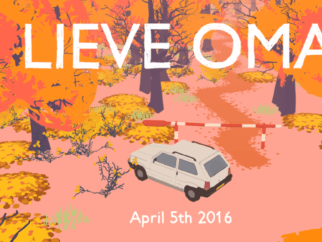Lieve Oma, which means Dear Grandma in Dutch, is developer Florian Veltman’s ode to his grandmother who, like for many of us, is an emotional anchor and pivotal figure in his upbringing and development. In Lieve Oma you play as a young girl who is brought to the woods by her grandmother in order to collect mushrooms. The act of collecting fungi only serves as an excuse for the elderly woman to spend some time with her granddaughter since it soon becomes apparent that all is not right in her life.
Viewed from an isometric angle, Lieve Oma involves you following your grandmother down a woodland path, diverting slightly every now and then to pick up mushrooms. The controls are very basic given the limited gameplay and you can play with a mouse and keyboard or controller setup. The arrow keys, WASD, ZQSD or the left joystick move the character; left click, spacebar, return or any face button is used to interact with the environment and advance the dialogue; shift or either the triggers will cause the character to run; and the mouse or right joystick are used to rotate the camera.
A single screenshot of Lieve Oma’s striking art direction is what initially drew me to the game and after starting Lieve Oma the visuals became even more alluring. The style,  which is reminiscent of that seen in Proteus, is very simple but extremely effective. Since the entire game takes place in this forestry setting, it’s obvious that the assets have been are reused and repeated but my eyeballs never grew weary of staring at the gnarled branches of trees, reflective puddles and piles of fallen leaves underfoot. And every time a new piece of environmental art was introduced such as a babbling brook or pile of charred logs it felt like a treat. The art also possesses the ability to represent different biomes and seasons with parts of the game being set in autumn and some being set in the winter. The warm, bright autumnal colours of the fall contrast with the muted blues, white and greys of the winter creating a truly atmospheric sense of space.
which is reminiscent of that seen in Proteus, is very simple but extremely effective. Since the entire game takes place in this forestry setting, it’s obvious that the assets have been are reused and repeated but my eyeballs never grew weary of staring at the gnarled branches of trees, reflective puddles and piles of fallen leaves underfoot. And every time a new piece of environmental art was introduced such as a babbling brook or pile of charred logs it felt like a treat. The art also possesses the ability to represent different biomes and seasons with parts of the game being set in autumn and some being set in the winter. The warm, bright autumnal colours of the fall contrast with the muted blues, white and greys of the winter creating a truly atmospheric sense of space.
The animation, whilst subtle, is equally effective with the girl’s posture changing over time as she becomes more comfortable voicing her anxieties and more comfortable with herself. The footsteps left on the terrain and the small puff of condensed breath seen coming from girl in the winter are nice touches also. The art and animation are complemented by the excellent sound design. The ambient sounds add to the atmosphere and although the soundtrack is not very diverse, the soft piano riffs successful evoke an emotional response. As the girl opens up to her grandmother and details of her slightly troubled home life become more apparent, the music changes accordingly; becoming more melancholic and sombre.
There is an age old debate of what exactly constitutes as a game and perhaps developers seem to think that their projects need to outwardly portray some semblance of interactivity to be considered a game and therefore be of any worth or value. However, this  doesn’t need to be the case nowadays when people’s expectations have been tempered and not every game has to contain complex mechanics. Lieve Oma is a walking simulator and unapologetically so. You walk through an intentionally visible woodland path; straying off said path will quickly lead to an invisible wall; there are no dialogue trees or branching outcomes; it’s short and holds little to no replay value. Lieve Oma never shies away from being story-driven and even describes itself as a short narrative game so this leads me to question why there is the option (and it is an option, not at all mandatory) to collect mushrooms.
doesn’t need to be the case nowadays when people’s expectations have been tempered and not every game has to contain complex mechanics. Lieve Oma is a walking simulator and unapologetically so. You walk through an intentionally visible woodland path; straying off said path will quickly lead to an invisible wall; there are no dialogue trees or branching outcomes; it’s short and holds little to no replay value. Lieve Oma never shies away from being story-driven and even describes itself as a short narrative game so this leads me to question why there is the option (and it is an option, not at all mandatory) to collect mushrooms.
Not only does collecting mushrooms serve the purpose of getting the young girl to spend time with her grandmother, but it also projects a false illusion that there is a gameplay element included in the experience. You can collect a mushroom and show it to your grandmother and she will tell you whether it is edible or not and this is seemingly where the fungi stop being of any relevance. There is a counter that tallies the number of mushrooms you have collected but this is just appears to be an arbitrary number rather than any variant that will change the outcome of the game (I played it twice to check) other than the grandmother saying what type of meal you can make from your selection. In my review of Three Fourths Home I criticised the need to continually press the right trigger to accelerate the car as it confuses the player to believe that it has an effect on the gameplay so I must aim the same criticism here in Lieve Oma. Collecting mushrooms holds absolutely no purpose, at least from what I’ve found, and should have either had a meaningful mechanic and pay off attached to it or be scrapped entirely.
Games such as Lieve Oma that have little to no gameplay rely on other pillars of game design to make a splash; notably visual design, sound design and story. There can be no argument that the art and musical presentation are superb but I ultimately feel that the story  doesn’t quite match them in their brilliance. Before I go into why I believe the story didn’t live up to expectation, I’ll first elaborate on what I thought worked. Lieve Oma successfully captures the relationship between the girl and her grandmother and their portrayals of youth versus maturity. Instead of cajoling the young girl with matriarchal mithering, the grandmother is patient and allows her to open up gradually. For the girl, initially many of her responses are a ‘sure’ or a ‘whatever’ or just an ellipsis in the dialogue bubble, which one can imagine is just a grunt or grumble from a nonchalant teenager. Adolescent problems that seem almost trivial as an adult such as not being close to your friends are put under the microscope and help you understand where she is in life. The dichotomy between the characters is heart-warmingly relatable and the dialogue between them exudes a sense of mutual love and respect.
doesn’t quite match them in their brilliance. Before I go into why I believe the story didn’t live up to expectation, I’ll first elaborate on what I thought worked. Lieve Oma successfully captures the relationship between the girl and her grandmother and their portrayals of youth versus maturity. Instead of cajoling the young girl with matriarchal mithering, the grandmother is patient and allows her to open up gradually. For the girl, initially many of her responses are a ‘sure’ or a ‘whatever’ or just an ellipsis in the dialogue bubble, which one can imagine is just a grunt or grumble from a nonchalant teenager. Adolescent problems that seem almost trivial as an adult such as not being close to your friends are put under the microscope and help you understand where she is in life. The dichotomy between the characters is heart-warmingly relatable and the dialogue between them exudes a sense of mutual love and respect.
Although it wasn’t clear straight away, the winter levels take place sometime in the near future, probably when she’s around seventeen and has recently learned how to drive. In the first two winter levels the girl receives a call from her grandmother just to check up on her but in the last winter level no call is received. I took this to mean that the grandmother had passed in the time since the last winter level and whilst this was sorrowful it was also bittersweet by virtue of the fact the girl still frequented the forest either as a reminder of her times with her grandmother or to carry on the tradition that had been ingrained in her since childhood. The fact that she is still driving the car that had been given to her by her grandmother, or the fact that she sees a blue heron in the stream that her grandmother was eager to see years ago are subtle yet evocative messages of just how much our elders influence and better our lives and how remorseful we are when they are gone.
Now onto my criticisms. Firstly, there are ample moments in the game where neither of the characters talk and I believe these quiet moments could have been filled with much needed dialogue to push the narrative forward. The little girl takes time to open up, which would be true for most closeted teenagers, but when your game is only half an hour long, by the time she’s ready to reveal more the credits are already rolling. As stated before, in two of the winter levels you receive a call from your grandmother as you near the end of the woodland path and much of these levels are spent in silence. I understand this design decision for the last winter level because it makes it easier to understand t hat the grandmother has passed and allows for quiet reflection, but the other two winter levels could have been filled with an inner monologue from the girl to further understand the issues she had faced in the past and how her life had progressed since. In the end you don’t find out why her parents split up or if she settled into her new school or why her mother hadn’t moved into her own bedroom. The girl’s more upbeat tone, stance and walk in the later levels suggest that these issues had been resolved and perhaps these problems were simply superficial and the moral of the story centres around the fact that the grandmother was there for her in her time of need. However, it would have been nice if some of these blanks (and there are many) had been filled in as these growing pains felt intrinsic to the development of the girl’s character. I like games that are slightly open-ended and allow you to draw your own conclusion from their narratives but in Lieve Oma it just feels that the story and the good but very limited script that could fit on a piece of A4 paper were lacklustre and there isn’t even enough information for you to reflect upon after the game finishes.
hat the grandmother has passed and allows for quiet reflection, but the other two winter levels could have been filled with an inner monologue from the girl to further understand the issues she had faced in the past and how her life had progressed since. In the end you don’t find out why her parents split up or if she settled into her new school or why her mother hadn’t moved into her own bedroom. The girl’s more upbeat tone, stance and walk in the later levels suggest that these issues had been resolved and perhaps these problems were simply superficial and the moral of the story centres around the fact that the grandmother was there for her in her time of need. However, it would have been nice if some of these blanks (and there are many) had been filled in as these growing pains felt intrinsic to the development of the girl’s character. I like games that are slightly open-ended and allow you to draw your own conclusion from their narratives but in Lieve Oma it just feels that the story and the good but very limited script that could fit on a piece of A4 paper were lacklustre and there isn’t even enough information for you to reflect upon after the game finishes.
Despite my criticisms, I’m happy to have played Lieve Oma and I’m delighted that these sort of experiences exist. You can choose to run down the forest path and whizz through its half an hour runtime but there’s a lot of subtly and delicate detail that you’ll miss so Lieve Oma is a game to approach with a relaxed state of mind and one that you’ll want to absorb slowly (the atmosphere alone is worth savouring). Whilst I feel that the mushroom mechanic was needless and the story under-delivers, there is so much that Lieve Oma does right. The sound design and art direction are excellent, the characters are believable whilst their relationship is organic and there are a few heart-warming moments. Despite having a close bond with my own grandmother, Lieve Oma didn’t resonate with me entirely but I wouldn’t be surprised if a lot of people out there relate to this bittersweet story.
Many thanks to Florian Veltman for providing Indie Marathon with a copy of Lieve Oma for review! You can pick up Lieve Oma now for £2.99/$3.77 over at itch.io.

- Atmospheric
- Superb Visual & Sound Design
- Believable Characters
- Subtle, Heart-Warming Moments
- Story Ultimately Under-Delivers
- Pointless Mushroom Mechanic
- Dialogue Too Sparse & Limited








